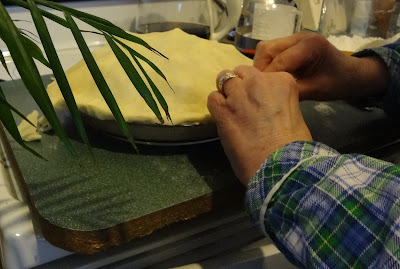She taught me the basics of bread and pastry but I'm afraid one of the things I came away with was her tendency to suggest I add a little of this, maybe a little of that and when I rather impatiently asked how I was supposed to know how much to add, her famous last words were always, "You'll know by the feel of it."
It's many years later but I now know why she said that and yes, I do know by the feel of it.
I still talk to people all the time who tell me they can't make a pie crust. I understand that because I couldn't, for the longest time. I remember the tears of frustration when I was trying to roll out a sheet of pastry and it was breaking apart and sticking to the rolling pin and splitting in the middle. I remember putting it into the pie plate in pieces and splicing it together and using a wet thumb to try and patch it into submission.
What a mess. You might get away with it if you were making a one-crust pie and you were going to cover that disaster with a tasty filling but if you were set on an apple pie with a top crust, you were right out of luck.
I regularly saw — in magazines or newspapers or cookbooks — the promise of a recipe for a "no-fail-pie-crust." All fake, believe me.
But then one day, my luck changed. I was telling you a few weeks ago about a little set of cookbooks I'd found called, The Wonderful World of Cooking. Each of the four books contained recipes from different parts of the world and in this one, I found what I'd been looking for:
On page 238, with no country's name attached, is a recipe for "Pastry for 9-inch pie." There are four ingredients, such basic ingredients, they're right at your fingertips. You barely have to move five steps in your kitchen to assemble them.
They are: 1 cup flour, ½ tsp. salt, 1/3 cup shortening, 3-4 tablespoons cold water.
What could be simpler, right? How could I not do this?
The first thing I'll advise is, obey the recipe when it says "cold." Make sure your shortening is cold right out of the fridge and put an ice cube in your little glass of water.
And get one of these:
This made all the difference.
The second thing I would advise is: don't pay attention if the recipe says "blend shortening and dry ingredients until it resembles small peas." What does that even mean? Just work the shortening into the flour until the shortening is all incorporated.
When it comes to adding the ice water, this is where Mum would say, "You'll be able to tell by the feel of it." Of course, she was right. I know that now and I could say the same thing but I try to avoid it.
The recipe says 3-4 tablespoons. I sprinkle about three tablespoons over the flour mixture and mix lightly with a fork. When I suspect I'm close, I pinch a bit of the dough between thumb and forefinger. It shouldn't be sticky but it should stick together. You might have to use all four tablespoons. Remember that you shouldn't over-handle it but it should "come together" and not crumble. Recipes always say to chill before you roll and I guess that's a good idea. I don't always though — depends on whether I have time.
If you've played all your cards right and the stars have aligned, you should be able to roll your pastry into a ball, pat it into a disc, sprinkle some flour on to it, and get out the rolling pin. And let the rolling pin do the work. Don't lean too heavily.
And here's your final product.
Or maybe this. (These are apple and mincemeat.)
This really is the most basic and, I would say, fool-proof pastry recipe there is. If you think you can't make a pie, I urge you to try it and let me know it worked.
Once you've mastered it, you will know the feel of it and you can work in some variations: maybe you'd prefer lard or butter to the shortening. For a savoury pie, you can stir in some grated cheese and some herbs. You can be your creative self and feel a great sense of accomplishment at the same time.
Bon appétit!





No comments:
Post a Comment